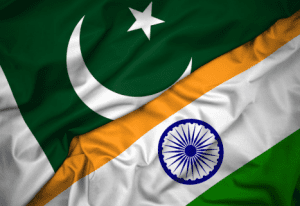New Delhi – In a swift and calculated response to a rapidly evolving security landscape, India has deployed its indigenously-built aircraft carrier, INS Vikrant, to the western seaboard, marking a critical move aimed at bolstering maritime vigilance and regional deterrence. The decision follows a string of high-stakes developments — including the terrorist attack in Pahalgam, Kashmir on April 22, a missile test notification by Pakistan off the Karachi coast, and a perceptible surge in hostilities along the Line of Control (LoC). The strategic redeployment of INS Vikrant — India’s flagship naval asset — underscores New Delhi’s resolve to counter cross-border aggression with assertive military readiness.
🇮🇳 INS Vikrant: India’s Floating Fortress
INS Vikrant, commissioned into the Indian Navy in September 2022, stands as a symbol of India’s naval self-reliance and technological prowess. Housing MiG-29K fighter jets, Kamov helicopters, and long-range radar systems, the 45,000-tonne carrier is equipped to lead maritime operations and surveillance missions across the Indian Ocean Region (IOR). According to defense officials, the deployment near Pakistan’s maritime boundary is intended to assert maritime deterrence amid the ongoing tensions and protect India’s strategic shipping lanes.
🔥 Backdrop: Pahalgam Terror Attack and Border Security
 The naval deployment follows the April 22 terrorist attack in Pahalgam, Jammu & Kashmir, which claimed the lives of 9 security personnel and injured several civilians. The attack has been linked to cross-border terrorist operatives, prompting a nationwide alert. In response, India has not only intensified military deployments but also suspended the Indus Waters Treaty and shut down the Attari-Wagah border crossing, indicating a major policy shift in Indo-Pak diplomacy.
The naval deployment follows the April 22 terrorist attack in Pahalgam, Jammu & Kashmir, which claimed the lives of 9 security personnel and injured several civilians. The attack has been linked to cross-border terrorist operatives, prompting a nationwide alert. In response, India has not only intensified military deployments but also suspended the Indus Waters Treaty and shut down the Attari-Wagah border crossing, indicating a major policy shift in Indo-Pak diplomacy.
🚀 Pakistan Missile Test Triggers Strategic Monitoring
Further stoking tensions, Pakistan issued a Notice to Mariners (NOTAM) for a surface-to-surface missile test scheduled for April 24–25 within its Exclusive Economic Zone (EEZ) off the Karachi coast. Indian defense and surveillance agencies, including the Navy and the Strategic Forces Command, are closely monitoring the missile window to assess the threat potential and calibrate responses accordingly.
🌐 International Repercussions and U.S. Travel Advisory
The United States has responded to the developments by updating its travel guidelines for India. The U.S. Department of State has issued a “Do Not Travel” advisory for Jammu and Kashmir, including tourist zones like Pahalgam, Gulmarg, and Srinagar, citing the high risks of terrorism and civil unrest. This adds international scrutiny to the regional instability and pressures both nations to avoid escalation.
🛡️ India’s Enhanced Strategic Readiness
India’s current defense ecosystem is significantly bolstered by:
-
Rafale fighter jets with SCALP and Meteor missiles,
-
The S-400 air defense system,
-
MQ-9B Predator drones for high-altitude ISR missions,
-
A robust tri-service coordination mechanism under the Chief of Defence Staff (CDS).
The Navy, in coordination with the Indian Air Force and the Strategic Forces Command, is executing multi-layered monitoring, with special focus on the Karachi Port, Gwadar Port, and surrounding sea lanes.
🔍 Strategic Implications and Regional Stability
Analysts see the INS Vikrant deployment not just as a reaction, but as part of a broader strategic doctrine to:
-
Ensure maritime dominance in the Indian Ocean,
-
Deter any potential Pakistani military adventurism,
-
Assure domestic political stakeholders and global allies of India’s defense commitment.
With general elections looming, the current government is also under pressure to display firm national security leadership.
📌 Conclusion


Official INS Vikrant Details – Indian Navy.

